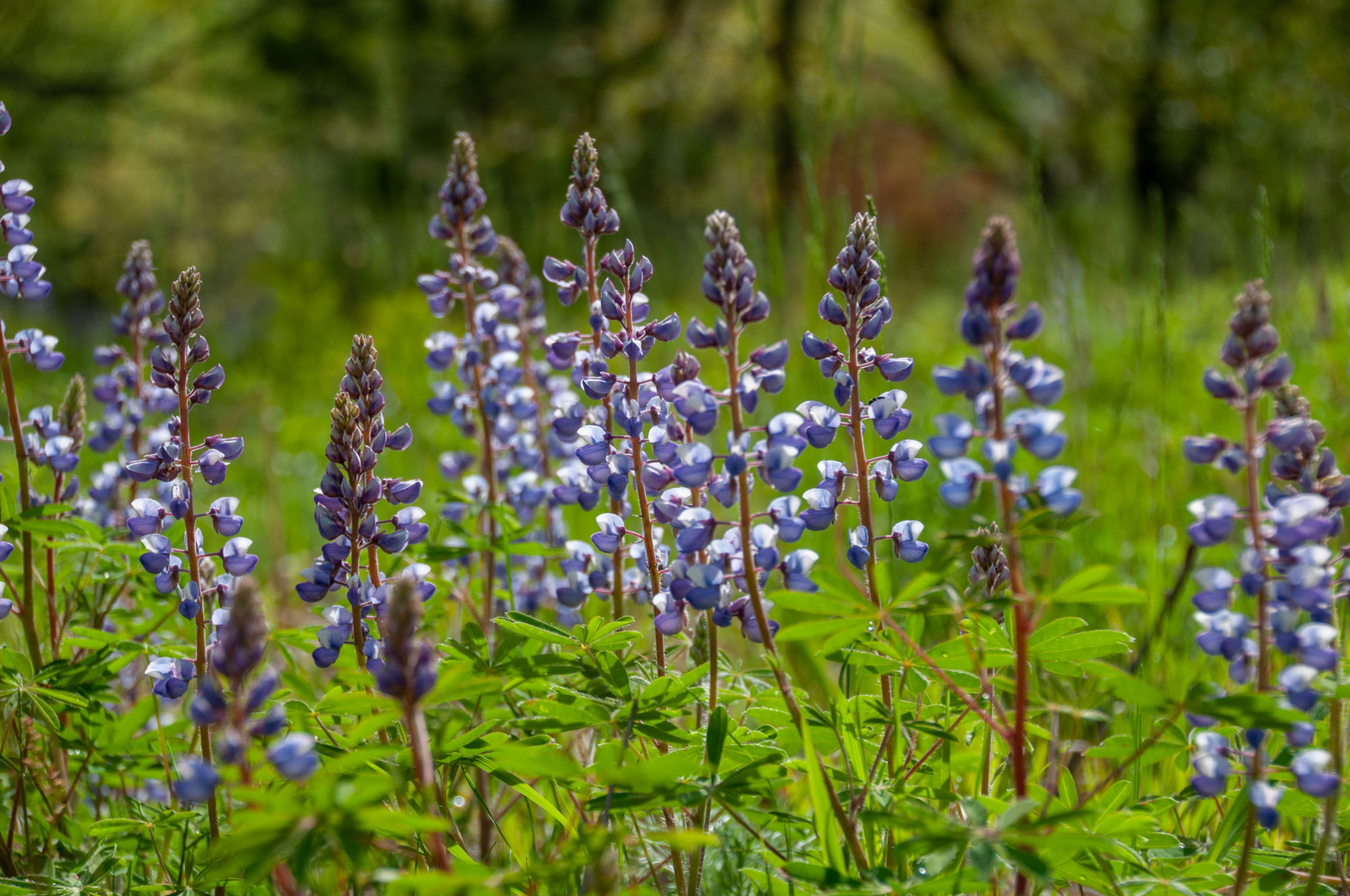
Trees planted to support forest resilience at Flower Creek Dunes Nature Preserve show early signs of success
There is a lot to love about the forest at Flower Creek Dunes Nature Preserve. Its steep dune ridges are shaded by beautiful hemlocks, beeches, maples, and oaks. The towering trees provide shelter and food for migrating and resident birds. Foxes, bobcats, and porcupines are known to roam the forest floor.
But the unique beauty and important ecosystem services this forest provides are at great risk. Invasive pests, pathogens, and climate change all threaten the integrity of the forest. The Land Conservancy of West Michigan is employing several tools to protect the trees that are there and ensure the long-term health of the forest. One tool we are using? Planting more trees.
In 2021, in cooperation with Trout Unlimited and with funding from U.S. Forest Service and Great Lakes Restoration Initiative, volunteers joined us at the preserve to plant nearly 4,000 trees at Flower Creek Dunes Nature Preserve across two different sites. Our goal was to help the forest become more resilient to predicted future pests and severe drought as a result of climate change. The species were carefully selected to meet several criteria to ensure their success—from how likely they are to be browsed by deer, to how likely they are to thrive in warmer temperatures caused by climate change. The species selection was also informed by projections modeled by the Northern Institute of Applied Climate Science and includes many that are at or near the northern end of their natural range here in West Michigan, such as tulip poplar, eastern red cedar, hackberry, and pawpaw.
The tree seedlings were carefully planted in the soil, and a waiting game began. Newly planted trees must survive drought, falling dead trees, pests and diseases, and most of all, being snacked on by deer and other critters. After the first year, it is common for only 50% of seedlings to have survived. Thanks to a survey performed by volunteer and recent graduate of Michigan Technological University, Anna DeBraber, we know that 80% of the trees volunteers planted in 2021 have survived.
“Surviving the first year is a big step for future viability. It shows that the general conditions (soil, moisture, sunlight, etc.) are at least conducive for growth for these species,” said Lucas Dykstra, LCWM Stewardship Manager. “Being artificially planted is a very stressful thing for a plant, so their recovery from that stress says quite a bit. More importantly, deer haven’t completely decimated them! That said, there’s still a long way to go and a lot can happen.”
Several of the surveyed trees show signs of browsing by deer, but so far, they have survived it. We will continue to monitor their success in the years to come.
Anna recently shared her experience completing the survey, and her reflections capture much of what is special about the forest at Flower Creek Dunes and our efforts to save it. Read our interview with her below.
LCWM: What inspired you to volunteer to support the work of the Land Conservancy?
Anna: Going to school in Houghton, where you can stand atop a hill and see only forest in every direction, I realized how important the Land Conservancy’s work is in an area like West Michigan, where land is such a valuable resource for agriculture, real estate, and other human-centric needs. Growing up here, I found my “nature nearby” to be a sanctuary where the loudness of the world was kept at bay, my curiosity was nurtured, and I connected deeply with the people I loved. Part of my decision to come back home after school was to ensure that future generations have that same luxury. The work that the Land Conservancy does preserving and restoring the ecosystems native to the region are in line with those values, so I reached out hoping that my technical skills could be of use. Fortunately, they had a project perfectly suited to my expertise, and gave me the opportunity to be a part of their incredibly meaningful work. It is such a gift to be in nature with a purpose.
Can you describe your experience surveying the newly planted trees at Flower Creek Dunes?
I had never been to Flower Creek Dunes Nature Preserve before. When I had considered it as a hike I was discouraged by the lack of easy public access, but once I arrived it was just a matter of walking along the shoreline. That is an experience in itself, with the sand forcing you to move slowly and deliberately while the waves playfully lap at your heels. I am now in the habit of removing my hiking boots to navigate that section, feel the sand between my toes, and greet the lake on my way to the preserve.
This project was explained to me as an experimental climate change mitigation project. As temperatures warm and weather patterns become more erratic, many tree species are expected to struggle to grow at the same rate. The presence of invasive species only worsens this problem, working together with climate change to lower survival rates of seedlings and cut the lives of adult trees short. As it stands now, the forest at Flower Creek Dunes is a gorgeous mix of tall, strong sugar maple, beech, and hemlock, among other species. All these species have factors working against their ability to thrive in the future, so this planting is an effort to determine which trees, if any, would be appropriate replacements. Many of these species are typically found dominating further south, where the trees are more adapted to higher temperatures.
There are two sites where the trees are planted on the preserve. The first is a ridge right off the trail straddled by ravines. The forest floor is primarily fallen leaves from years past and the soil is on the sandy side (as can be expected at a dunes preserve bordering Lake Michigan). Each seedling is marked by a bamboo post painted denoting the species planted there. When I arrived the first time, it felt as though every direction I looked revealed more brightly colored bamboo, and the prospect of keeping track of each of them was daunting. They are not labeled beyond their species, so to not double count seedlings requires focused attention.
For each tree, I wrote down whether they were alive or browsed by deer. Everywhere I have worked and learned in the Midwest, there are struggles with deer overpopulation and the stress that puts on native vegetation. Not only did I see evidence of this at Flower Creek Dunes, the first time I surveyed I found myself not two feet from a fawn, curled up in a depression in the earth behind a fallen log. We both stared at each other for a long while, unsure of what to do next. Slowly, shakily, unsteadily the fawn stood and wobbled away to hide behind a nearby hemlock. It watched as I continued to survey, doing my best to avoid sudden movements or eye contact. Even though I knew these seedlings would suffer for the presence of this young creature I could not bring myself to resent its existence in any way. It was a reminder not only that I was a guest in that space, but of the complexity that working with living creatures inevitably brings.
Being alone in the woods inevitably brings out something in us that we mostly keep hidden. For me, that is my willingness to personify any living creature. I found myself letting the eastern red cedars know how proud I was of them, using their sharp needles to keep browse away and growing quickly compared to their broad-leaved companions. My heart went out to the river birches, struggling to put out leaves in the spring after having their terminal buds nibbled off. In contrast, the size of the paw-paw leaves fascinated me. They thrived despite browsing, and after going to school so many miles north were new to me. As a volunteer, I had the freedom to take my time with these new friends, thoroughly examining leafless stems to determine mortality. Without the pressure of my time being money, I could fully appreciate all the preserve had to offer while still feeling as though my presence there was contributing to its health.
The second site requires something more of an adventurous spirit than the first. Half of the seedlings are planted on a steep dune, and the only appropriate verb for how I accessed these trees is “scrambling.” During my first visit I slowly worked my way up, switch-backing to the top to find the disparate bamboo stakes hidden by the vertical backdrop. The view from the top of the dune was breathtaking. Lake Michigan stretched for miles ahead, outlined by the canopy of trees whose roots were located dozens of feet below me. My experience of nature has been that effort is rewarded, whether through an obviously remarkable feature or simply a sense of peace, accomplishment, and connection.
Every time I have visited the preserve it has kept me far longer than I intended to be there. It feels like a friend who I see rarely but connect with immediately, and I always leave a slightly better person than when I arrived. I’m excited for the future of the Flower Creek Dune Nature Preserve and grateful for the Land Conservancy for setting it up for success, come what may. To be a part of that work has been such a joy already, and hopefully will be for long into the future.





Joe Engel
Excellent and evocative piece, Anna. Thanks for sharing your experience, and obvious passion. Joe
Annette Byers
Thanks for your beautiful writing and for sharing your love of nature..
Beth Miller
Wow! Your article was a gift to me this morning., Anna! Thank you for your words, your work, and your heart for nature.
Joanne Basta
Anna, What a beautiful essay! I used to live near the Flower Creek Preserve and spent a lot of time walking the shoreline, swimming, exploring the dunes and forest. It really contributed to my health and spirit as a young person, and it will always stay in my heart. I am so thankful to the Land Conservancy for their work, and was excited to know about this climate mitigation project. It prompted me to look at my eastern tree books to visualize what paws paws and tulip trees look like. (I live in the Sonoran Desert now). I hope we can get updates on how these trees are doing over time. Best to you and the other volunteers who contributed to this work.
Mike Kramer
We love the flower creek area. The viewing platform over the Flower Creek Estuary is very cool. The view from the platform at the top of the dune is spectacular! We live about 1 mile from the conservancy and will volunteer for any event. Currently there are 5 bald eagles living in the area. I haven’t found the nest yet, but I have seen 3 yearlings and 2 adults at one time. it would be great if there was a looped trail around the forest area and back out to the beach. We like to hike from the south stairs to the flower creek estuary overlook and then along the creek trail back out to lake Michigan.